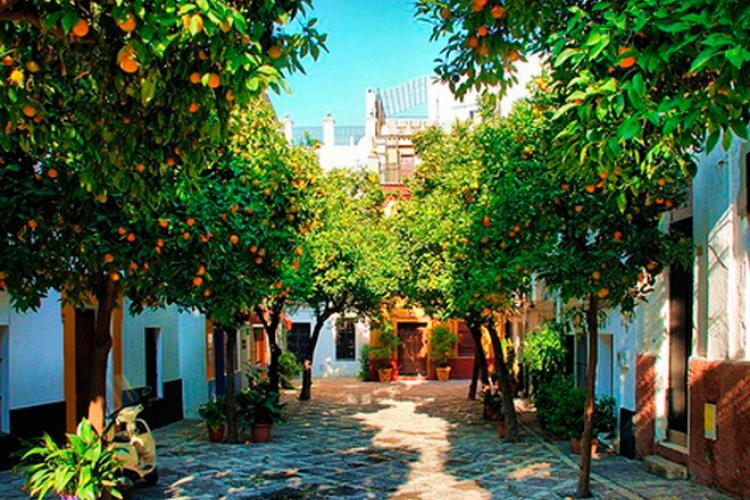Seville, a culinary stroll
Seville is full of food surprises as well as tradition.
The capital of Andalucia is one of Spain´s most romantic cities and many of its famous sites now have World Heritage status. Seville´s rich culture is matched by an equally rich culinary tradition which reflects the unique history and geography of the area.
The city of Seville wakes up slowly. But even if you like to see the sun rise, there is sure to be a welcoming café open somewhere nearby. Join the city´s workers as they prepare for the coming day with a steaming cup of café con leche. The classic breakfast is simply half a toasted roll, a tostada, which is topped with olive oil, crushed ripe tomatoes and perhaps a sliver of garlic. This can be washed down with glass of marvellous freshly squeezed orange juice for a vitamin boost during the winter months when oranges are in season.
Typical dishes
Typical cuisine can be found all over the city, but remember that, in Seville, lunch starts late. The city lies inland and is famous for its high summer temperatures and a great way to cool down after a busy morning of sight-seeing is with a glass of manzanilla wine or fino sherry, which are both produced in the region. In summer, move on to a bowl of gazpacho, a light and refreshing cold soup prepared with tomato, cucumber, pepper, onion, garlic, vinegar, and olive oil.
One of the best lunch dishes for winter is huevos a la flamenca, This is prepared with dry-cured Spanish ham, tomato, onion, potatoes, sausage, red pepper (Spanish paprika) and peas. The rich seasoning comes from the addition of olive oil and sherry and the dish is usually served in small individual clay pots.
Pescaitos fritos is another tempting dish you will find everywhere and also a reminder that the sea is not far away. Small fish, such as anchovy and whitebait are tossed in slat and flour then deep-fried and piled high on to a platter set off with lemon wedges. This is a dish to share with friends and you should not feel shy about using your fingers.
Tapas trail
In the afternoon a siesta is obligatory, while the arrival of dusk means hitting the tapas trail. Seville boasts some wonderful historic bars which are set apart by their distinctive tilework or azulejos and rows of suspended hams slowly revolving to the rhythm of the ceiling fans. Favourite tapas in the city – small saucer sized portions served with drinks - include espinacas con garbanzos, spinach with chick peas and transparent slices of sweet Andalucían hams.
It should not be difficult to whet your appetite for the culinary delights of dinner. A hearty Seville specialty is solomillo al whiskey, which is pork cooked in whisky. Or what about cola de toro? Stewed with a rich red wine such as Rioja, bull´s tail is a delicious and warming dish to enjoy when autumn brings a chill to the air.
Sweet tooth
Those with a sweet tooth will find much to please in Seville. The historic quarter of Triana is famous for housing one of the oldest known ovens. The Horno San Buenaventura dates from 1385 and the recipes for many of the delicious sweet treats it once baked have been passed intact down the generations. Tortas de aceite are thin, crispy and sweet cakes made with olive oil, flour, wheat, sugar, sesame, anise and a sprinkling of salt. Melt-in-the-mouth polvorones are prepared from wheat flour, lard, and sugar and are guaranteed to destroy your waistline. Rich and chewy Alfajores are a sweet treat prepared with almonds, walnuts and honey and another reminder of the exotic Moorish heritage in the south of Spain.
Bitter oranges
Bitter Seville oranges have become famous all over the world for the tangy marmalade they produce. No other orange has the same intense distinctive flavour and the sharpness of the orange creates a prefect counterbalance to the sweetness of the sugar. This type of orange is also very rich in pectin which is the substance that helps jams and jellies to set properly. Because of this, the pips and pith can be used as a setting agent for any type of jam or jelly.
In Seville itself, bitter oranges add a twist to many local deserts. There are several local versions of tarte au citron, for example, which feature bitter oranges rather than lemons. Another favourite desert is arroz con leche, where the humble rice pudding is taken to a new level with the addition of some aromatic orange zest. Seville oranges also form the base of great classic dishes like duck à l’orange and are used to flavour a host of other savoury and sweet dishes. Bitter oranges can be seen ripening all over the province of Seville a month or two before Christmas. But take note that the orange season is not very long. It lasts from late December through to February and then there is a long wait for another year.

